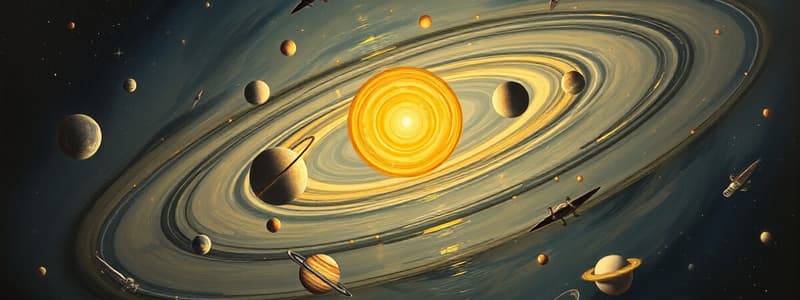Podcast
Questions and Answers
How are planets affected by their location within the solar system?
How are planets affected by their location within the solar system?
Planets travel in an elliptical orbit around the sun, with those closer to the sun having faster average orbital speeds and receiving more heat, while those farther away are cooler.
What are the physical properties of Mercury?
What are the physical properties of Mercury?
Mercury has extremely hot temperatures on the side facing the sun, a little atmosphere, cold temperatures on the side not facing the sun, and is the smallest planet. A day on Mercury is almost as long as its year.
What are the physical properties of Venus?
What are the physical properties of Venus?
Venus has a thick atmosphere, the hottest temperature of the planets, a size similar to Earth, rotates very slowly, and in the opposite direction. A day on Venus is longer than its year.
What are the physical properties of Earth?
What are the physical properties of Earth?
What are the physical properties of Mars?
What are the physical properties of Mars?
What are the physical properties of Jupiter?
What are the physical properties of Jupiter?
What are the physical properties of Saturn?
What are the physical properties of Saturn?
What are the physical properties of Uranus?
What are the physical properties of Uranus?
What are the physical properties of Neptune?
What are the physical properties of Neptune?
What are the physical properties of asteroids?
What are the physical properties of asteroids?
What are the physical properties of comets?
What are the physical properties of comets?
Asteroids are objects made of ________ and _________ that orbit the sun but are too small to be considered planets.
Asteroids are objects made of ________ and _________ that orbit the sun but are too small to be considered planets.
Most asteroids revolve around the sun in an orbit between those of _______ and _________.
Most asteroids revolve around the sun in an orbit between those of _______ and _________.
They form a wide band called the Asteroid _______.
They form a wide band called the Asteroid _______.
Other asteroids have orbits that cross Earth's orbit. These asteroids are called _________.
Other asteroids have orbits that cross Earth's orbit. These asteroids are called _________.
Asteroids probably consist of matter that never agglomerated into a ______ when the solar system was forming.
Asteroids probably consist of matter that never agglomerated into a ______ when the solar system was forming.
The comet's core is composed of _______ and _______.
The comet's core is composed of _______ and _______.
Comets heat up and begin to ________ as they approach the sun.
Comets heat up and begin to ________ as they approach the sun.
The matter surrounding a comet's core is vaporized and forms a very bright halo of _______, and an enormous cloud of ________ envelopes the head of the comet.
The matter surrounding a comet's core is vaporized and forms a very bright halo of _______, and an enormous cloud of ________ envelopes the head of the comet.
Tiny particles expelled from the comet's core make up the dust's _____ of the comet, which is several million kilometers long.
Tiny particles expelled from the comet's core make up the dust's _____ of the comet, which is several million kilometers long.
Most comets orbit around the sun in very _______ orbits that take them out to the edge of the solar system, beyond Pluto's orbit.
Most comets orbit around the sun in very _______ orbits that take them out to the edge of the solar system, beyond Pluto's orbit.
Study Notes
Planetary Characteristics
- Planets travel in elliptical orbits around the Sun, with closer ones moving faster due to stronger gravitational pull.
- Temperature varies based on proximity to the Sun; inner planets are hotter, while outer planets are cooler.
Individual Planet Profiles
- Mercury: Smallest planet with extreme temperatures; no atmosphere and no moons.
- Venus: Thick atmosphere, hottest planet, rotates slowly in retrograde; has no moons.
- Earth: Supports life, has moving tectonic plates and is mostly water; one moon with a thin atmosphere.
- Mars: Known as the red planet due to iron oxide; has the largest canyon, thin atmosphere, and two moons.
- Jupiter: Largest planet; features the Great Red Spot, thick atmosphere of ammonia and hydrogen; has 67 moons.
- Saturn: Famous for its rings made of ice and rock; no solid surface, composed mostly of hydrogen and helium; has 62 moons.
- Uranus: Unique axial tilt, rings of dust and rock; comprised mostly of hydrogen and helium; has 27 moons.
- Neptune: Strongest winds in the solar system; thick atmosphere primarily of hydrogen and helium; has 14 moons.
Asteroids and Comets
- Asteroids: Made of rock and metal, too small to be classified as planets, primarily found between Mars and Jupiter in the asteroid belt.
- Near Earth Objects: Asteroids that have orbits intersecting Earth's orbit, called near-Earth objects.
- Formation: Asteroids are remnants that never formed into planets during the solar system's creation.
Comet Structure and Behavior
- Comet cores consist of dust and ice; they heat and melt as they approach the Sun.
- The halo around a comet's core is made of vaporized gases, notably hydrogen.
- The tail of a comet, sometimes millions of kilometers long, consists of tiny particles expelled from the core, extending behind the comet during its orbit.
- Comets typically have highly eccentric orbits that can extend beyond Pluto.
Studying That Suits You
Use AI to generate personalized quizzes and flashcards to suit your learning preferences.
Description
Test your knowledge of how planetary location affects their orbits, speeds, and temperatures in our solar system. These flashcards cover essential concepts and details about each planet's unique characteristics based on their distance from the sun. Ideal for students looking to enhance their understanding of astronomy.




